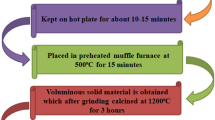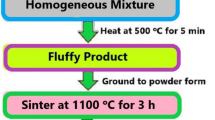Abstract
A series of Ca9Gd(VO4)7: Dy3+ (x = 0.01–0.20) nanophosphor crystals emitting a cool white light were synthesized by solution combustion methodology. The X-ray diffraction patterns were analyzed and processed using Rietveld refinement. The fabricated nanophosphor was found to crystallize in a trigonal crystal lattice with space group R3c(161). The morphological behavior of the prepared nanophosphor was investigated using transmission electron microscopy (TEM) and scanning electron microscopy (SEM). The photoluminescence properties of the nanophosphor correspond to cool white emission upon near-ultraviolet (NUV) excitation at 327 nm due to 4F9/2 → 6H15/2 (bluish) and 4F9/2 → 6H13/2 (yellowish) radiative relaxations at 487 nm and 576 nm respectively. Also, there is a strong occurrence of double charge transfer from O2− ions to Dy3+ and V5+ ions with the latter being stronger due to the high positive charge of V5+ ions. Color coordinates (x = 0.2878, y = 0.3259) are consistent with white emission. Auzel's model was implemented to examine the non-radiative relaxation (113.5 ms−1), radiative lifetime (1.4856 ms), and quantum efficiency (83.13%) values. The crystalline and optical behavior of the synthesized cool white emitting nanophosphor facilitates its use in near-UV-based WLEDs and other advanced solid-state lighting.






Similar content being viewed by others
Availability of Data and Materials
The data used in the current research work can be made available on reasonable request from the corresponding author (Dr. Rajesh Kumar Malik).
References
Pust P, Weiler V, Hecht C et al (2014) Narrow-band red-emitting Sr[LiAl3N4]:Eu2+ as a next-generation LED-phosphor material. Nature Mater 13:891–896. https://doi.org/10.1038/nmat4012
Liu M, Lü W, Huo J et al (2016) Syntheses, crystal structures and photoluminescence properties of Ca 9 Y(PO 4) 5 (SiO 4)F 1.5 O 0.25: Ln 3+ (Ln 3+ = Eu 3+ /Tb 3+ /Dy 3+ /Sm 3+ ) phosphors for near-UV white LEDs. RSC Adv 6:92371–92377. https://doi.org/10.1039/C6RA21254A
Chen H-Y, Yang R-Y, Chang S-J (2010) Improving crystalline morphology and photoluminescent properties of BaY2ZnO5:Eu3+ phosphors prepared using microwave assisted sintering. Mater Lett 64:2548–2550. https://doi.org/10.1016/j.matlet.2010.08.023
Baur F, Glocker F, Jüstel T (2015) Photoluminescence and energy transfer rates and efficiencies in Eu 3+ activated Tb 2 Mo 3 O 12. J Mater Chem C 3:2054–2064. https://doi.org/10.1039/C4TC02588A
Zhang K, Liu H, Wu Y, Hu W (2007) Synthesis of (Y, Gd)3Al5O12: Ce nanophosphor by co-precipitation method and its luminescence behavior. J Mater Sci 42:9200–9204. https://doi.org/10.1007/s10853-007-1913-2
Dalal M, Taxak VB, Dalal J et al (2017) Crystal structure and Judd-Ofelt properties of a novel color tunable blue-white-red Ba 5 Zn 4 Y 8 O 21: Eu 3+ nanophosphor for near-ultraviolet based WLEDs. J Alloy Compd 698:662–672. https://doi.org/10.1016/j.jallcom.2016.12.257
Wang J, **g X, Yan C et al (2006) Influence of fluoride on f–f transitions of Eu3+ in LiEuM2O8 (M=Mo, W). J Lumin 121:57–61. https://doi.org/10.1016/j.jlumin.2005.10.003
Zhong J, Chen D, Zhou Y et al (2016) New Eu 3+ -activated perovskite La 0.5 Na 0.5 TiO 3 phosphors in glass for warm white light emitting diodes. Dalton Trans 45:4762–4770. https://doi.org/10.1039/C5DT04909A
Niu P, Liu X, Wang Y, Zhao W (2018) Photoluminescence properties of a novel red-emitting phosphor Ba2LaV3O11:Eu3+. J Mater Sci Mater Electron 29:124–129. https://doi.org/10.1007/s10854-017-7895-1
Kolesnikov IE, Kalinichev AA, Kurochkin MA et al (2019) Structural, luminescence and thermometric properties of nanocrystalline YVO4:Dy3+ temperature and concentration series. Sci Rep 9:2043. https://doi.org/10.1038/s41598-019-38774-6
Kaur H, Jayasimhadri M (2021) Spectroscopic and color tunable studies in Dy3+/Eu3+co-doped calcium-bismuth-vanadate phosphor for lighting applications. Solid State Sci 122:106776. https://doi.org/10.1016/j.solidstatesciences.2021.106776
Phogat P, Khatkar SP, Malik RK et al (2021) Crystal chemistry and photoluminescent investigation of novel white light emanating Dy3+ doped Ca9Bi(VO4)7 nanophosphor for ultraviolet based white LEDs. Mater Chem Phys 270:124828. https://doi.org/10.1016/j.matchemphys.2021.124828
Phogat P, Taxak VB, Malik RK (2022) Crystallographic and Optical Characteristics of Ultraviolet-Stimulated Dy3+-Doped Ba2GdV3O11 Nanorods. J Electron Mater 51:4541–4554. https://doi.org/10.1007/s11664-022-09711-7
Li L, Wang G, Huang Y et al (2011) Crystal growth and spectral properties of Nd3+:Ca9Gd(VO4)7 crystal. J Cryst Growth 314:331–335. https://doi.org/10.1016/j.jcrysgro.2010.11.114
Zheng F, Sun S, Feng Y et al (2020) Yb:Ca9Gd(VO4)7, a potential ultrafast pulse laser crystal with promising spectral properties. J Lumin 221:117085. https://doi.org/10.1016/j.jlumin.2020.117085
Qian S, Ma Y, Dai Z et al (2013) Photoluminescence properties of Na+-free and Na+ co-doped Ca9Gd(VO4)7:Eu3+, Dy3+. Mater Res Bull 48:521–525. https://doi.org/10.1016/j.materresbull.2012.11.003
Liu Q, Li X, Zhang B et al (2016) Structure evolution and delayed quenching of the double perovskite NaLaMgWO6:Eu3+ phosphor for white LEDs. Ceram Int 42:15294–15300. https://doi.org/10.1016/j.ceramint.2016.06.169
Liu Y, Zhang J, Zhang C et al (2015) Ba 9 Lu 2 Si 6 O 24: Ce 3+ : An efficient green phosphor with high thermal and radiation stability for solid-state lighting. Adv Opt Mater 3:1096–1101. https://doi.org/10.1002/adom.201500078
Sehrawat P, Malik RK, Punia R et al (2021) New Ba2YAlO5:Dy3+ nanomaterials for WLEDs: Propellant combustion synthesis and photometric features for enhanced emission of cool-white light under NUV excitation. Chem Phys Lett 781:138985. https://doi.org/10.1016/j.cplett.2021.138985
Yousefi SR, Amiri O, Salavati-Niasari M (2019) Control sonochemical parameter to prepare pure Zn0.35Fe2.65O4 nanostructures and study their photocatalytic activity. Ultrason Sonochem 58:104619. https://doi.org/10.1016/j.ultsonch.2019.104619
Ekambaram S, Patil KC (1997) Synthesis and properties of Eu2+ activated blue phosphors. J Alloy Compd 248:7–12. https://doi.org/10.1016/S0925-8388(96)02622-9
Ekambaram S, Patil KC (1995) Combustion synthesis of yttria. J Mater Chem 5:905. https://doi.org/10.1039/jm9950500905
Stutzman PE, Struble L (2015) Instructions in Using GSAS rietveld software for quantitative x-ray diffraction analysis of portland clinker and cement. National Institute of Standards and Technology
Toby BH (2001) EXPGUI, a graphical user interface for GSAS. J Appl Crystallogr 34:210–213. https://doi.org/10.1107/S0021889801002242
Muniz FTL, Miranda MAR, Morilla dos Santos C, Sasaki JM (2016) The Scherrer equation and the dynamical theory of X-ray diffraction. Acta Crystallogr A Found Adv 72:385–390. https://doi.org/10.1107/S205327331600365X
Kubelka P (1948) New Contributions to the Optics of Intensely Light-Scattering Materials Part I. J Opt Soc Am 38:448. https://doi.org/10.1364/JOSA.38.000448
Monshi A, Foroughi MR, Monshi MR (2012) Modified Scherrer Equation to Estimate More Accurately Nano-Crystallite Size Using XRD. World J Nano Sci Eng 02:154–160. https://doi.org/10.4236/wjnse.2012.23020
Pan Z, Yu H, Cong H et al (2012) Polarized spectral properties and laser demonstration of Nd-doped Sr 3 Y 2 (BO 3) 4 crystal. Appl Opt 51:7144. https://doi.org/10.1364/AO.51.007144
Mendhe MS, Puppalwar SP, Dhoble SJ (2018) Efficient energy transfer and fluorescence in SrYAl 3 O 7: Ce 3+, Tb 3+ phosphor. Optik 166:15–23. https://doi.org/10.1016/j.ijleo.2018.04.006
Vishwakarma AK, Jha K, Jayasimhadri M et al (2015) Emerging cool white light emission from Dy 3+ doped single phase alkaline earth niobate phosphors for indoor lighting applications. Dalton Trans 44:17166–17174. https://doi.org/10.1039/C5DT02436F
Yu C, Chen B, Zhang X et al (2020) Influence of Er 3+ concentration and Ln 3+ on the Judd-Ofelt parameters in LnOCl (Ln = Y, La, Gd) phosphors. Phys Chem Chem Phys 22:7844–7852. https://doi.org/10.1039/C9CP06755H
Suresh C, Nagabhushana H, Darshan GP et al (2018) Facile LaOF: Sm 3+ based labeling agent and their applications in residue chemistry of latent fingerprint and cheiloscopy under UV–visible light. Arab J Chem 11:460–482. https://doi.org/10.1016/j.arabjc.2017.09.014
Sehrawat P, Khatkar A, Boora P et al (2020) A novel strategy for high color purity virescent Er3+-doped SrLaAlO4 nanocrystals for solid-state lighting applications. J Mater Sci Mater Electron 31:6072–6083. https://doi.org/10.1007/s10854-020-03160-w
Huang X, Guo H (2018) A novel highly efficient single-composition tunable white-light-emitting LiCa 3 MgV 3 O 12: Eu 3+ phosphor. Dyes Pigm 154:82–86. https://doi.org/10.1016/j.dyepig.2018.02.047
Huang X, Guo H (2018) LiCa 3 MgV 3 O 12: Sm 3+ : A new high-efficiency white-emitting phosphor. Ceram Int 44:10340–10344. https://doi.org/10.1016/j.ceramint.2018.03.043
Phogat P, Khatkar SP, Malik RK et al (2021) Crystallographic and Judd-Ofelt Parametric investigation into Ca9Bi(VO4)7:Eu3+ nanophosphor for NUV-WLEDs. J Lumin 234:117984. https://doi.org/10.1016/j.jlumin.2021.117984
Yaba T, Wangkhem R, Shanta Singh N (2019) Photoluminescence Properties of Dy3+ Activated CaWO4 Nanophosphors: a Potential Single Phase near White Light Emitter. J Fluoresc 29:435–443. https://doi.org/10.1007/s10895-019-02352-w
Deng Y, Yi S, Wang Y, **an J (2014) Synthesis and photoluminescence characteristics of Ln3+ (Ln=Sm, Er and Dy)-doped BaGd2(MoO4)4 phosphors. Opt Mater 36:1378–1383. https://doi.org/10.1016/j.optmat.2014.03.036
Dhanalakshmi M, Nagabhushana H, Darshan GP et al (2017) Sonochemically assisted hollow/solid BaTiO 3: Dy 3+ microspheres and their applications in effective detection of latent fingerprints and lip prints. J Sci Adv Mater Devices 2:22–33. https://doi.org/10.1016/j.jsamd.2017.02.004
Grobelna B, Synak A, Bojarski P et al (2013) Synthesis and luminescence characteristics of Dy3+ ions in silica xerogels doped with Ln2−xDyx(WO4)3. Opt Mater 35:456–461. https://doi.org/10.1016/j.optmat.2012.09.040
Dalal H, Kumar M, Sehrawat P et al (2022) Crystallographic and photophysical aspects of combustion derived novel Dy3+-activated BaSrGd4O8 nanophosphor for advanced solid-state lighting applications. J Mater Sci Mater Electron. https://doi.org/10.1007/s10854-022-08307-5
Grzyb T, Wiglusz RJ, Nagirnyi V et al (2014) Revised crystal structure and luminescent properties of gadolinium oxyfluoride Gd 4 O 3 F 6 doped with Eu 3+ ions. Dalton Trans 43:6925–6934. https://doi.org/10.1039/C4DT00338A
Blasse G (1968) Energy transfer in oxidic phosphors. Phys Lett A 28:444–445. https://doi.org/10.1016/0375-9601(68)90486-6
Christy AA, Kvalheim OM, Velapoldi RA (1995) Quantitative analysis in diffuse reflectance spectrometry: A modified Kubelka-Munk equation. Vib Spectrosc 9:19–27. https://doi.org/10.1016/0924-2031(94)00065-O
Auzel F (2002) A fundamental self-generated quenching center for lanthanide-doped high-purity solids. J Lumin 100:125–130. https://doi.org/10.1016/S0022-2313(02)00457-X
Devi S, Kaushik S, Kumar M et al (2022) Influence of Eu3+ do** on crystallographic and photophysical aspects of combustion synthesized BaSrY4O8 nanophosphor for photoelectronic appliances. Appl Phys A 128:23. https://doi.org/10.1007/s00339-021-05125-0
McCamy CS (1992) Correlated color temperature as an explicit function of chromaticity coordinates. Color Res Appl 17:142–144. https://doi.org/10.1002/col.5080170211
Dalal H, Sehrawat P, Sheoran M et al (2021) Optical, crystallographic and Judd-Ofelt analysis of europium doped Sr6Y2Al4O15 nanocrystals for NUV-WLED fabrication. J Mater Sci Mater Electron. https://doi.org/10.1007/s10854-021-07347-7
Acknowledgements
The authors are highly thankful to the department of chemistry, Maharshi Dayanand University, Rohtak for providing chemicals and instrumental facilities.
Funding
The author, Hina Dalal, received financial support from the University Grants Commission in the form of SRF (Award no. 49/(CSIR-UGC NET JUNE 2019)) to carry out this research work properly.
Author information
Authors and Affiliations
Contributions
Hina Dalal and Mukesh Kumar: Data analysis, original draft writing, Suman Devi and Priyanka Sehrawat: Review Writing, Monika Sheoran, Poonam Devi and Neeraj Sehrawat: Conceptualization and Methodology, Rajesh Kumar Malik: Results discussion and supervision.
Corresponding author
Ethics declarations
Ethical Approval
The research work presented in this paper is new and has not been published in any other journal. We will follow all norms of the publications like copyright etc.
Competing Interests
The authors declare that they have no known competing personal relationships or financial interests that could have appeared to influence the work reported in the current paper.
Additional information
Publisher's Note
Springer Nature remains neutral with regard to jurisdictional claims in published maps and institutional affiliations.
Rights and permissions
Springer Nature or its licensor (e.g. a society or other partner) holds exclusive rights to this article under a publishing agreement with the author(s) or other rightsholder(s); author self-archiving of the accepted manuscript version of this article is solely governed by the terms of such publishing agreement and applicable law.
About this article
Cite this article
Dalal, H., Kumar, M., Devi, S. et al. Combustion Synthesis and Study of Double Charge Transfer in Highly Efficient Cool White-emitting Dy3+ Activated Vanadate-based Nanophosphor for Advanced Solid-state Lighting. J Fluoresc 33, 497–508 (2023). https://doi.org/10.1007/s10895-022-03098-8
Received:
Accepted:
Published:
Issue Date:
DOI: https://doi.org/10.1007/s10895-022-03098-8




